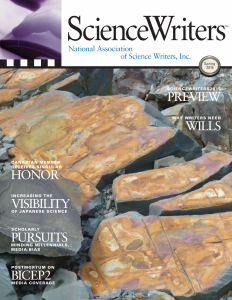Academic research relevant to the workaday world of science writing
Minding millennials, media bias
By Rick Borchelt
There has been a spate of research papers recently about how and why different audiences acquire and react to news; sometimes about science and sometimes about news more generally. Two captured my attention for what they can offer science communicators as we daily confront changes in the news landscape.
The first concerns where new audiences for news are coming from. There’s a persistent mental image of how Millennials, adults aged roughly 18-34, acquire and process news. It’s not a flattering one: The worry many observers express is that Millennials are disconnected from traditional news-gathering processes as passive audiences for a stream of social media that delivers information to them in a pattern more akin to Brownian movement than mindful news acquisition.The truth is much different, according to the Media Insight Project, a collaboration of the American Press Institute and the Associated Press–NORC Center for Public Affairs Research. Their new study finds that “this newest generation of American adults is anything but ‘newsless,’ passive, or civically uninterested.”
“This generation tends not to consume news in discrete sessions or by going directly to news providers. Instead, news and information are woven into an often continuous but mindful way that Millennials connect to the world generally, which mixes news with social connection, problem solving, social action, and entertainment,” the study explains. “Rather than having a narrowing effect on what Millennials know about, however, the data suggest this form of discovery may widen awareness.”
Among the study’s (sometimes surprising) findings:
- While Millennials are highly equipped, it is not true they are constantly connected. More than 90 percent of adults age 18-34 surveyed own smartphones and half own tablets. But only half (51 percent) say they are online most or all of the day.
- Email is the most common digital activity, but news is a significant part of the online lives of Millennials, as well. Fully 69 percent report getting news at least once a day; 40 percent several times a day.
- Millennials acquire news for many reasons, which include a fairly even mix of civic motivations (74 percent), problem-solving needs (63 percent), and social factors (67 percent) such as talking about it with friends.
- Contrary to the idea that social media creates a polarizing “filter bubble,” exposing people to only a narrow range of opinions, 70 percent of Millennials say that their social media feeds are comprised of diverse viewpoints evenly mixed between those similar to and different from their own. An additional 16 percent say their feeds contain mostly viewpoints different from their own. And nearly three-quarters of those exposed to different views (73 percent) report they investigate others’ opinions at least some of the time, with a quarter saying they do it always or often.
The study had both telephone survey and focus group components. Focus groups were mostly conducted in coffeehouses.
“Millennials follow news about a wide variety of subjects and do so across a range of sources,” the study authors found. “The average Millennial reports regularly following 9.5 different news and information topics among the 24 included on the survey.” “TV, Music, and Movies” was the category most likely to garner Millennials’ attention: Two of three Millennials say they follow this news category on a regular basis: The second-highest ranking category (mentioned by 60 percent of Millennials) was news and information about a hobby.
Despite these patterns, Millennials don’t ignore hard news, however, the report points out. “More people under 35 say they follow politics, crime, technology, their local community, and social issues, for instance, than report following popular culture and celebrities or style and fashion. Nearly all of these young adults follow what are traditionally considered hard news topics. The average Millennial follows about four hard news topics and 45 percent of Millennials follow five or more.”
“Younger Millennials are just as likely to follow hard news topics as older ones. In our qualitative interviews, we saw what may be clear reasons why. Virtually everyone we talked to had some areas of passion or deep interest, which may have been related to career, heritage, travel experience, or some other factor. And they tended to be quite conscious and active in the ways they sought information about those areas, identifying experts that they followed, news organizations that they trusted, and more,” the study notes.
The key for those of us who want our news to be part of the information diets of Millennials is to match their assessments of which experts and what institutions become trusted information sources.
“How Millennials Get News: Inside the Habits of America’s First Digital Generation,” The Media Insight Project, American Press Institute, bit.ly/1EULG21.
The second recent paper reflects the constant refrain from passionate advocates about most any controversial topic: Activists, no matter which side of the issue they’re on, claim the media are biased against their particular take on a contentious issue. Sometimes, it seems, fighting against hostile media even seems to ignite a spark of issue activism.
This tendency for individuals who feel strongly about an issue to view media coverage of that issue, regardless of its objective content, as biased against their position is referred to as the hostile media effect, explain Lauren Feldman of Rutgers University and her colleagues in a paper in Communication Research. She and her team focused on the role of hostile media in climate change activism.
“[H]ostile media perceptions are most pronounced among highly involved partisans — or the so-called ‘hardcore’ individuals who are certain of their opinions and thus speak out regardless of the perceived opinion climate,” Feldman, et al., observed. Previous work on stem-cell activism suggests that “hostile media perceptions are a component of ‘issue public’ membership, whereby individuals are especially interested and invested in a particular issue and, as such, feel compelled to participate to influence the climate of opinion and rally support for their views,” the team recounts. “Perceptions of a hostile media are likely to activate these participatory inclinations. If the media are viewed as hostile and capable of influencing the public at large, this creates a greater perceived need for issue-focused partisans to get involved and take actions such as contacting public officials, joining a demonstration, or signing a petition.” Hostile media perceptions also may fuel activism by stimulating negative emotional reactions toward the media, known as ‘media indignation,’ which arises from the sense that biased media are a form of injustice and are the result of deliberate manipulation by powerful interest groups.
The researchers hypothesized that “the positive relationship between hostile media perceptions and climate activism will be isolated among political liberals. This is because the climate change issue public — that is, the segments of the American public who are ‘alarmed’ or ‘concerned’ about global warming — are disproportionately comprised of liberals,” they reasoned. “By the same logic, there is also a possibility that hostile media perceptions will mobilize conservatives to oppose climate action…It is thus more likely that hostile media perceptions will lead conservatives to avoid any form of activism that could serve to publicize the issue of climate change.” And because hostile media perceptions diminish an individual’s perception that they can have a political impact, the team further hypothesized that “[t]he negative relationship between hostile media perceptions and external political efficacy will be stronger among conservatives than among liberals.”
In other words, hostile media will motivate liberal activism and squelch conservatives on the issue of climate change.
Feldman’s group surveyed 1,000 Americans in late 2011 to test their hunches. The results were much more nuanced than they expected.
As predicted, “hostile media perceptions are directly associated with climate change activism but that this is moderated by political ideology,” they found. “That is, among liberals, hostile media perceptions are positively related to activism, whereas among strong conservatives, this relationship is negative. Among weak conservatives and moderates, hostile media perceptions have no direct relationship with activism. We further show that hostile media perceptions decrease external political efficacy for all ideological groups; however, this negative relationship is strongest among conservatives.” But contrary to their prediction, “political ideology did not moderate the link between external political efficacy and climate change activism” — conservatives were as likely as liberals in the face of hostile media to believe they could bring about political change, they explained.
Nuanced as it is, the take-home message for communicators seems to be that rallying against hostile media may be an effective way to boost activism, albeit incrementally. For climate activism, this effect would be most likely for liberals.
“While hostile media perceptions may help activate liberals, who tend to be sympathetic to the climate change cause, they may further alienate and disengage those who are predisposed to be dismissive or doubtful about global warming,” the authors note, but they find this is a doubleedged sword for democracy. “We find that hostile media perceptions mobilize some groups while deactivating others. Thus, with a polarized issue such as climate change, widespread perceptions of a hostile media bias may mean that only certain voices, rather than a plurality, will be heard.”
Feldman, Lauren et al. (2015). Do hostile media perceptions lead to action? The role of hostile media perceptions, political efficacy, and ideology in predicting climate change activism. Communication Research, Jan. 6, 2015, bit.ly/1MLqexN.
Rick Borchelt is director for communications and public affairs at the U.S. Department of Energy Office of Science.
(NASW members can read the rest of the Spring 2015 ScienceWriters by logging into the members area.) Free sample issue. How to join NASW.




